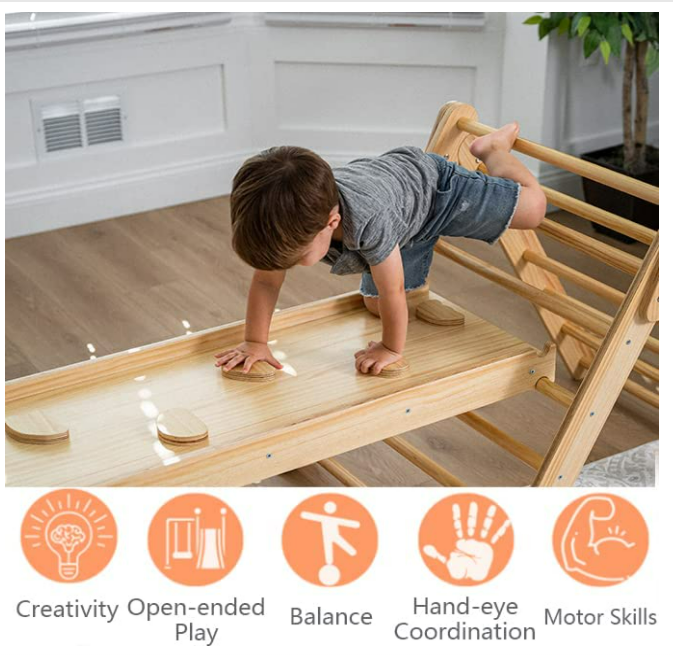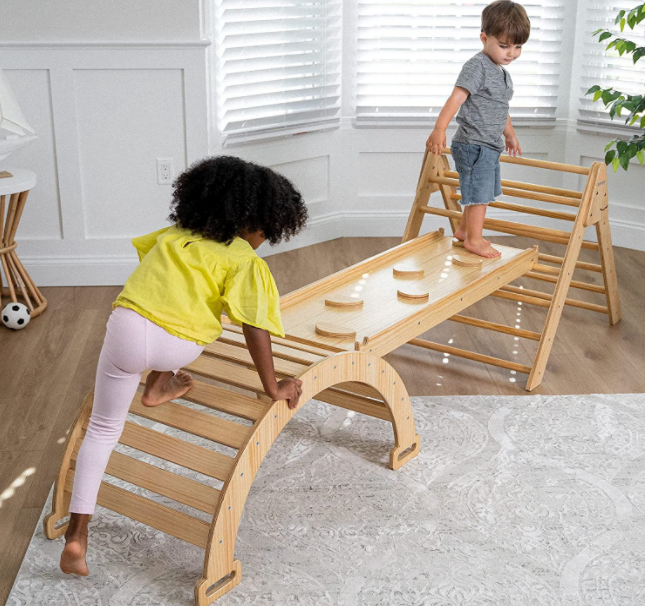Introduction Pikler Triangles are versatile wooden climbing structures that provide children with an opportunity to explore and learn through play.
In this article, we will discuss the benefits of owning a Pikler Triangle and the different types available in the market.
By the end of the article, you will have a good understanding of how to choose the best Pikler Triangle for your child.
What is a Pikler Triangle and Where Did the Idea Come From?
First things first, if this is the first you’re hearing of it, a Pikler Triangle is a type of climbing structure designed for young children. It was developed by Dr. Emmi Pikler.
Dr. Pikler was a Hungarian pediatrician, educator, and researcher who revolutionized the way we think about child development and early childhood education. She dedicated her life to studying and promoting the natural and spontaneous development of children.
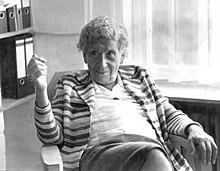
Dr. Pikler believed that children should be given the freedom to move and explore their environment at their own pace and in their own way. She observed that when children are allowed to move freely and are not forced to achieve developmental milestones before they are ready, they develop a strong sense of autonomy, self-confidence, and independence.
One of the key contributions that Dr. Pikler made to early childhood education was the development of the Pikler Approach, a child-centered approach to caring for infants and young children.
The Pikler Approach is based on the belief that children are competent and capable beings who are naturally curious and motivated to learn. One of the most well-known aspects of the Pikler Approach is the Pikler Triangle, a climbing structure that Dr. Pikler developed to help children develop their gross motor skills and promote physical development. The Pikler Triangle is a simple but versatile structure that can be used in a variety of ways, including as a climbing frame, a tunnel, and a fort.
Dr. Pikler believed that climbing and movement play were essential for children’s physical development and well-being. She observed that when children were given the opportunity to move and explore their environment freely, they developed stronger muscles, better balance and coordination, and increased confidence and self-esteem.
What age is a Pikler Triangle for?
The Pikler Triangle is a versatile climbing structure that can be used by children of various ages, depending on their developmental stage and physical abilities.
While the recommended age range for the Pikler Triangle is typically 6 months to 6 years, it is important to note that every child develops at their own pace and may be ready to use the Pikler Triangle at different ages.
For infants, the Pikler Triangle can be used as a safe and comfortable place for tummy time, allowing them to strengthen their neck and shoulder muscles and develop their gross motor skills.
The Pikler Triangle can also be used to support the child’s natural desire to explore and move, providing a safe and stimulating environment for early exploration.
As children grow and develop, the Pikler Triangle can be used to promote physical development and gross motor skills. Children can use the Pikler Triangle to climb, crawl, and balance, developing their strength, coordination, and balance.
The Pikler Triangle can also be used as a space for imaginative play, with children using it as a fort, tunnel, or obstacle course.
While the Pikler Triangle can be used by children up to the age of 6, it is important to monitor children’s use of the structure and ensure that they are using it safely and appropriately for their age and physical abilities.
It is also important to supervise children while they are using the Pikler Triangle and ensure that they are not using it in ways that could be dangerous or harmful.
Overall, the Pikler Triangle is a versatile and durable climbing structure that can be used by children of various ages and stages of development.
With its emphasis on child-led exploration and movement play, the Pikler Triangle can help children develop their physical abilities, confidence, and sense of autonomy.
How do you use a Pikler Triangle?
Children can use a Pikler Triangle in a variety of ways, including climbing up and down, crawling under it, and using it as a fort or tunnel. Parents can encourage play and exploration by introducing new challenges and obstacles.
Here are some ways to use a Pikler Triangle:
- Climbing: The Pikler Triangle is designed to support children’s natural inclination to climb. Children can climb up the ladder, stand on the platform, and then climb down the other side. Climbing on the Pikler Triangle helps children develop their strength, coordination, and balance.
- Crawling: Children can crawl under and around the Pikler Triangle, developing their gross motor skills and spatial awareness.
- Imaginative play: The Pikler Triangle can be used as a fort, tunnel, or obstacle course, encouraging imaginative play and creativity.
- Tummy time: Infants can use the Pikler Triangle as a safe and comfortable place for tummy time, developing their neck and shoulder muscles.
- Resting: Children can also use the Pikler Triangle as a place to rest, read a book, or just relax.
Here are some of the benefits of owning a Pikler Triangle
Pikler Triangles offer numerous benefits, including promoting gross motor skills, coordination, balance, creativity, and independence. They can also improve cognitive and social-emotional development and provide a safe and engaging environment for play.
Physical Benefits
- Improves gross motor skills
- Enhances balance and coordination
- Builds strength and endurance
Cognitive Benefits
- Encourages problem-solving and critical thinking
- Stimulates creativity and imagination
- Boosts confidence and self-esteem
Different Types of Pikler Triangles
There are various types of Pikler Triangles available in the market, including wooden, foldable, and plastic Pikler Triangles. Each type has its advantages and disadvantages.
Wooden Pikler Triangle
Advantages
- Durable and long-lasting
- Eco-friendly and sustainable
- Offers a traditional look and feel
Disadvantages
- Heavier and harder to move
- More expensive than other types
- Requires assembly
Foldable Pikler Triangle
Advantages
- Lightweight and easy to store
- Convenient for travel
- Offers portability
Disadvantages
- Less durable than other types
- Limited weight capacity
- Limited climbing options
Plastic Pikler Triangle
Advantages
- Lightweight and easy to clean
- Affordable
- Safe and durable
Disadvantages
- Limited climbing options
- Not eco-friendly
- Less aesthetically pleasing than other types
How to Choose the Best Pikler Triangle
When choosing a Pikler Triangle, there are several factors to consider, including age appropriateness, size and weight capacity, material and durability, safety features, and reviews and recommendations.
Age appropriateness
Make sure to choose a Pikler Triangle that is appropriate for your child’s age and development level. Some Pikler Triangles are designed for toddlers, while others are suitable for older children.
Size and weight capacity
Consider the size and weight capacity of the Pikler Triangle to ensure that it is safe and suitable for your child’s size and weight.
Material and durability
Choose a Pikler Triangle made from high-quality materials that are durable and safe for your child to use. Look for ones made from natural and non-toxic materials.
Safety features
Make sure the Pikler Triangle you choose has safety features such as rounded edges, stable legs, and a non-slip surface to prevent injuries.
Reviews and recommendations
Check reviews and recommendations from other parents to ensure that you are choosing a reliable and safe Pikler Triangle.
Popular Choices of Pikler Triangles
Lily and River Pikler Triangle
The Lily and River Pikler Triangle is a popular choice for parents looking for a high-quality wooden Pikler Triangle. It is made from premium birchwood and has a weight capacity of up to 100 pounds. It comes in a sleek, minimalist design and can be used in a variety of ways to encourage exploration and play.
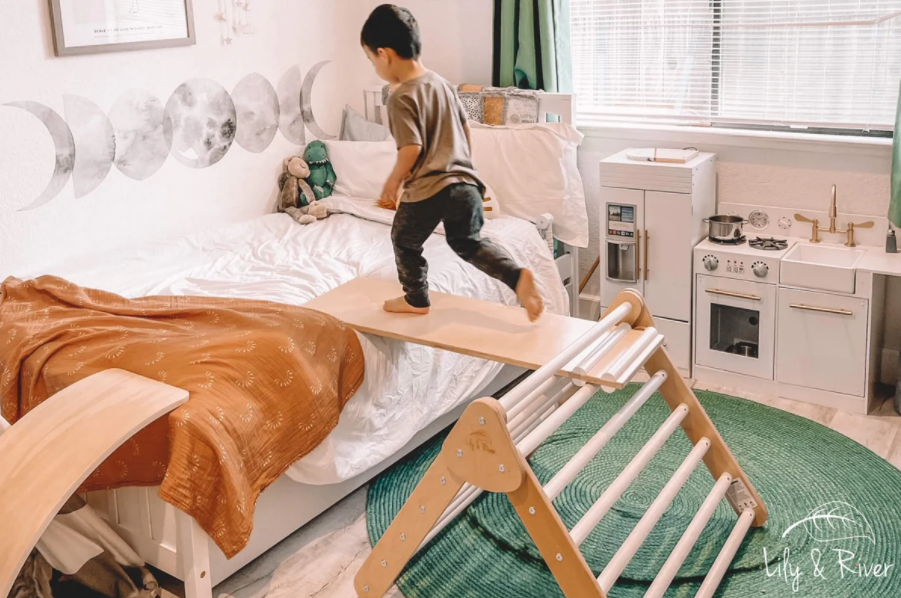
Pros
- Made from premium materials
- Sleek and minimalist design
- Durable and long-lasting
- Suitable for children of different ages and sizes
Cons
- More expensive than other Pikler Triangles
Wiwiurka Pikler Triangle
The Wiwiurka Pikler Triangle is another popular brand known for its high-quality wooden Pikler Triangles. It is made from solid wood and comes in a variety of sizes to suit children of different ages and developmental stages. It has a weight capacity of up to 220 pounds and can be used in a variety of ways to encourage gross motor skills and creativity.
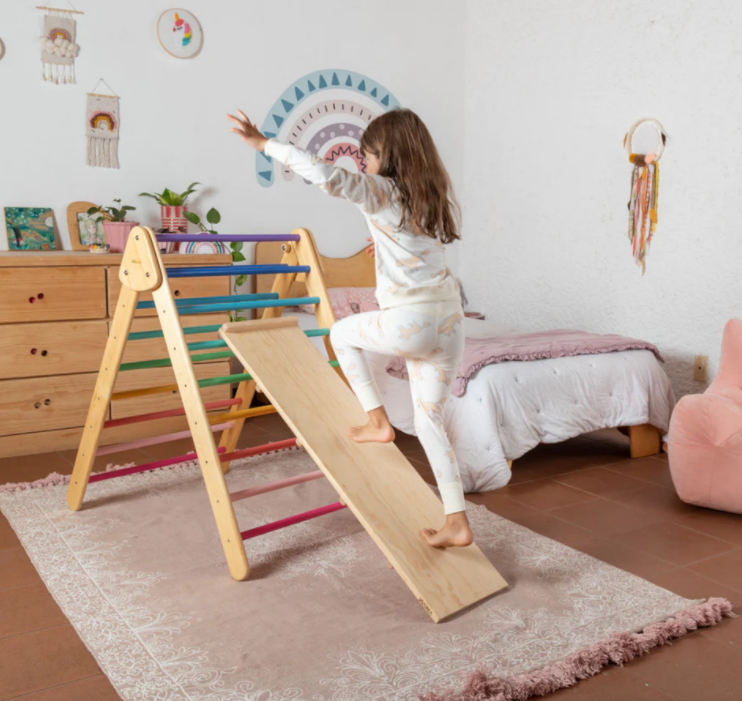
Pros
- Made from solid wood
- Comes in a variety of sizes
- Can support a higher weight capacity than other Pikler Triangles
- Can be used in various ways to encourage play and creativity
Cons
- More expensive than some other Pikler Triangles
- Assembly may take longer than other brands
Montessori Climbing Arch
The Montessori Climbing Arch is another popular Pikler Triangle brand that is designed to encourage children’s physical development and exploration. It is made from high-quality plywood and has a weight capacity of up to 100 pounds. It has a minimalist design and can be used in a variety of ways to encourage play and creativity.
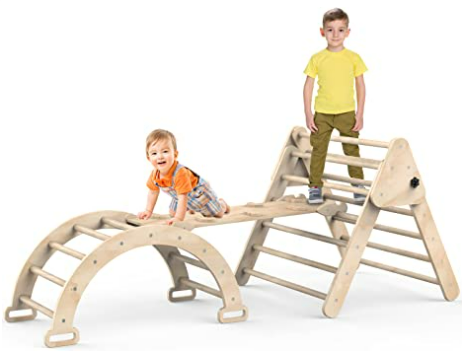
Pros
- Made from high-quality plywood
- Minimalist design
- Can be used in a variety of ways
- Suitable for children of different ages and sizes
Cons
- Assembly may take longer than other brands
- May be more expensive than some other Pikler Triangles
Based on the features and benefits of each brand, it is difficult to say which brand is the “best” as each has its advantages and disadvantages. It ultimately depends on your personal preferences and needs, such as budget, size, and material. It’s essential to do thorough research and read reviews before purchasing a Pikler Triangle to ensure that you’re making a well-informed decision.
Where to Buy a Pikler Triangle
You can buy Pikler Triangles from online retailers, local toy stores, and second-hand marketplaces. Make sure to buy from a reputable seller and check their return policy before making a purchase.
Pikler Triangles are excellent toys that offer numerous benefits for children’s physical and cognitive development. When choosing a Pikler Triangle, consider the type, age appropriateness, size and weight capacity, material and durability, safety features, and reviews and recommendations. Invest in a high-quality Pikler Triangle that will last for years and provide your child with endless hours of fun and learning.
How much does a Pikler Triangle cost?
The cost of a Pikler Triangle can vary depending on the brand, size, and materials. Prices can range from around $100 to over $500. Check current prices on Amazon.
Is a Pikler Triangle safe?
Yes, a well-made Pikler Triangle is safe for children to use when used correctly and under adult supervision. It’s important to choose a Pikler Triangle with safety features such as rounded edges, stable legs, and a non-slip surface to prevent injuries.
How big is a Pikler Triangle?
Pikler Triangles come in various sizes and designs, with some being larger or more complex than others. The size of a Pikler Triangle can depend on factors such as the age and size of the child using it, the amount of available space, and the desired level of challenge and complexity.
In general, a Pikler Triangle can range in size from approximately 3 feet wide and 3 feet tall to 6 feet wide and 4 feet tall. The ladder of a Pikler Triangle typically has between four and eight rungs, with the rungs spaced about 6 to 8 inches apart.
The average size of a Pikler Triangle is around 4 feet wide and 3 feet tall. This size is suitable for most children aged 6 months to 6 years, and it can be easily moved and stored in a home or playroom.
A Pikler Triangle of this size can provide a challenging and engaging climbing experience for children, helping them develop their gross motor skills, balance, and coordination.
However, some larger Pikler Triangles are available for those who have more space or want a more challenging climbing experience for their child. These larger Pikler Triangles can have multiple levels, tunnels, and accessories like rock walls or slides, and can be as large as 6 feet wide and 4 feet tall.
It is important to consider the available space and the age and abilities of the child when choosing a Pikler Triangle. A smaller Pikler Triangle may be more suitable for younger or smaller children, while a larger one may be more appropriate for older or more advanced climbers.
Additionally, it is important to ensure that the Pikler Triangle is safe and stable, with a soft surface underneath and proper supervision while in use.
How do you maintain a Pikler Triangle?
To maintain a Pikler Triangle, it’s important to regularly clean and inspect it for any signs of wear or damage. If necessary, you can reapply a protective finish to the wood to prevent damage and extend its lifespan.
alternative uses for pikler triangles
There are several alternative uses for a Pikler Triangle once your child has outgrown it, including:
- Convert it into a climbing wall – You can use the Pikler Triangle as the foundation for a larger climbing wall for older children or even adults.
- Repurpose it as a plant stand – The Pikler Triangle can be repurposed as a unique and eye-catching plant stand, adding a touch of nature to your home décor.
- Transform it into a reading nook – With a few modifications, you can transform the Pikler Triangle into a cozy and comfortable reading nook for your child.
- Donate or sell it – If you don’t want to keep the Pikler Triangle, you can donate it to a local preschool or daycare center, or sell it online to other families who are looking for a high-quality climbing structure.
- Use it for outdoor play – The Pikler Triangle can also be used for outdoor play, such as in a backyard or playground. With a weather-resistant finish, it can withstand exposure to the elements and provide endless hours of playtime.
Final Thoughts
The Pikler Triangle is an excellent investment for any family with young children.
Its design promotes physical activity, creativity, and imagination in a safe and engaging way.
It can be used both indoors and outdoors, and it grows with your child as they develop new skills and interests.
With a wide variety of sizes and styles available, there is a Pikler Triangle for every child and every family.
While it may be a significant investment, the benefits and longevity of the Pikler Triangle make it a worthwhile purchase.
So if you’re looking for a fun and educational toy that will inspire your child’s imagination and development, look no further than the Pikler Triangle.
Check current prices on Amazon.
